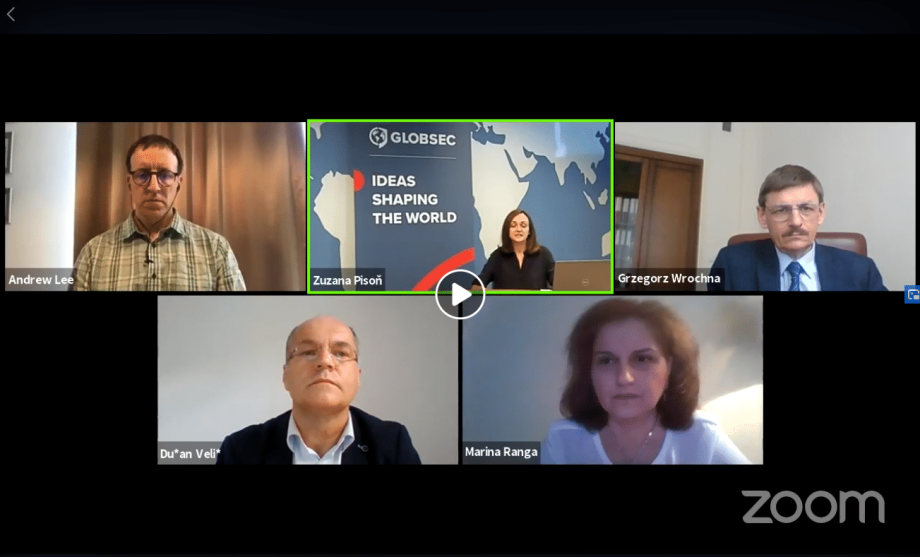Investing in Innovation: Key to Recovery? - Key Takeaways

The GLOBSEC Digital Lighthouse has launched in the fall of 2019 at Tatra Summit to kick-off a public-private platform that contributes to shaping policy debates in the area of digital transformation and innovations in the CEE region. The panellists met at a public virtual discussion on 29 July 2020, to discuss the impact of the COVID-19 crisis and most urgent issues facing the future of Innovation ecosystem in the EU and CEE. The summary of the discussed issues can be found below.
This webinar was powered by ESET, the founding partner of the Digital Lighthouse initiative.
Panellists
- Andrew Lee, Director of Government Affairs, ESET
- Marina Ranga, Expert at Joint Research Centre, European Commission
- Dušan Velič, Expert for Innovations, Science and Research at the Ministry of Investments, Regional Development and Informatization of the Slovak Republic
- Grzegorz Wrochna, Undersecretary of State at the Ministry of Science and Higher Education in Poland
The discussion was moderated by Zuzana Pisoň, Technology Stream Lead, GLOBSEC Policy Institute
Background
While the economic and social impact of the post-coronavirus era is yet to be fully seen, it is already clear that an effective recovery plan must support a stronger resilience of the EU´s economy. Investing in Europe’s innovation ecosystems is, therefore, one of the crucial instruments to start the post-COVID growth engine. The discussion tackled the desired strategies and key priorities in the post-pandemic recovery, which have a direct impact on the innovation ecosystem in CEE and the EU as a whole.
Key messages
Challenges of the innovation ecosystem in Europe and CEE in post-corona times
- The rising importance of multi-level governance – the new post-corona landscape highlights the importance of regional coordination on all levels.
- Uneven distribution of the innovation performance in Europe – moderate performers in the CEE region vs. strong performers in Western Europe.
- The development gap is not closing - between 2011-2019, average innovation performance increased by 67% for all EU regions, but only by 45% for modest innovators (RO, BG, PL)[1].
- Effective mechanisms & absorption capacity of MS to distribute EU funds are key for closing the gap.
- Ranga noted that the absorption capacity is influenced by the level of technology development, the density of innovation, distance from the technology frontier, quality of governance and political systems.
- The levels of innovation and investment are not the only things that shape the environment – we need to build resilient populations that can support the economy as the political and economic landscape changes.
- Lee highlighted the importance of access to connectivity in rural areas to close the development gap and allow people to engage in the new digital economy.
Reflections on the EU recovery plan & roads ahead
- Ranga noted that we shouldn’t expect “miracles” from the EU recovery plan - we are still facing the same structural challenges in research and innovation (R&I) in the EU and in MS.
- A new configuration of EU investment instruments for 2021-2027 is currently being prepared by MS, with emphasis on projects reflecting the green & digital agenda, as well as Europe for citizens stream.
- Wrochna emphasized the need to invest into research infrastructure and rapid response mechanisms to be prepared for future crises; according to him, the EU recovery plan should be a plan with a long-term perspective aiming to strengthen the EU’s resilience, not a shopping list.
- Lee stressed the need to invest in pan-European projects supporting Europe´s technological sovereignty. Europe needs to reduce its reliance on the US and Chinese technologies to improve its resilience with regards to the technological infrastructure.
CEE perspectives on innovation
- The road from research to innovation takes time and calls for a developed infrastructure. The situation in CEE with regarding technology transfer from research centres/universities to the market is not fully developed yet.
- Velič stated that Slovakia’s recovery plan includes launching a national program for innovations, synchronizing universities, governmental bodies and regions represented by industrial players.
- Wrong and Mr Velič agreed that the biggest challenge in the private sector with regards to innovations is risk-aversion. Therefore the role of the public sector is to reduce the level of risk to an acceptable level.
- Velič stated that competences to manage EU funds are now unified under the new ministry Ministry of Investments, Regional Development and Informatization of the Slovak Republic, with the aim to support innovations by
- creating knowledge clusters
- connecting universities, public and private sector
- focusing on the diversification of industry
- entrepreneurship in education
Digital & entrepreneurial skills are key for the recovery
- Digital competences and entrepreneurial skills among students and professionals are the basic pre-requisite for the innovation economy to work.
- Universities in Europe view each other as competitors. More collaboration is essential.
- Ranga noted that education and training for students and professionals are key to equip them with new management and technology development methods.
- JRC Program „Industrial transitions“ focusing on Bulgaria and Romania shows the urgent need for digital skills at every level of employment.
- Mr Lee stated that there’s a difference between the digital needs of a company and needs for a person studying technology to be able to carry out basic research. He further agreed with Mr Velič that combining perspectives of businesses, public sector and universities is essential in boosting capabilities of universities to do basic research.
[1] https://ec.europa.eu/growth/sites/growth/files/ris2019.pdf